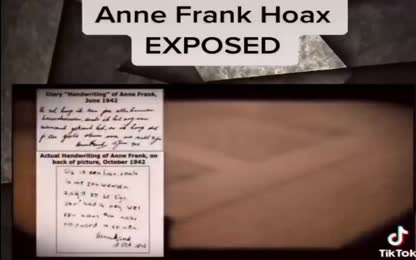Advertisement
1611 The Great Hoax Revealed In Print For The First Time
Video by MandoMohan
Published on 22 Apr 2014
Celebrating the new book by John Hudson. Shakespeare's Dark Lady. Hope you enjoy this most intriguing story.
Printed for the very first time in 1611 the true authorship of all the sonnets and plays ascribed to William Shakespeare is exposed by one work, Salve Deus, revealing the writer, Amelia Bassano Lanier, to be that very same scribe.
- Category: Blue Pills Swallower,Conspiracies / A secret plan
- Duration: 22:39
- Date: 2018-03-02 16:21:33
- Tags: dajorivision.wixsite.com/dajorivision
2 Comments
Video Transcript:
Hi, I'm John Hudson from the Dark Lady Players and we believe that plays William Shakespeare were actually written by a black Jewish woman called Amelia Bessine of Lania. This is a very revolutionary theory, but it's beginning to make sense. She was, after all, England's first published woman poet. She wrote a book in 1611 called Sourviedeus and she was also mistress to the man in charge of English theatre. What's more, we've found her signatures on seven of the plays. This is real. Mr Shakespeare did not come to London until probably 1592. That was when he first arrived. It is inconceivable to me that somebody coming from Stratford who would have had no way of having learnt Italian or Hebrew would have had no way of developing intense musical skills because none of his relatives were musical musicians and none of his communities as far as we know were professional musicians. There was no way that within like 12 months he could suddenly drop his Warwickshire accent, start writing standard English, but was intensely musical, making lots of Hebrew and Italian puns and referring to hundreds of literary works which he probably had no reason to read in Stratford. So there is just no social context that makes any sense. In 1622 the quarter of a fellow was published which has 163 lines missing from it which were then added in between 1622 and 1623 when the first folio was created. These 163 lines expand the part of the character Emilia and create the Willow song and Emilia is asked to repeat the Willow song. This combination of Emilia and Willow, dying like a swan to music is part of a broader pattern that exists right across all the Shakespearean plays which I call the swan signatures. You need to know that the dying swan to music which comes from Ovid is the standard image of the Renaissance poet, the Great Poet and there are two other places where it appears. The other place that appears is in Merchant of Venice where the person who is referring to is Bessanió, who is going to die like a swan in Portia's tears. This is no coincidence because these names Emilia, Johnson, Willow, Bessanió are the names of England's first published woman writer Emilia, Johnson, Willow, Bessanió. She has written her own names into the plays and associated them with the standard Renaissance image for the Great Poet as a way of showing us very clearly that she wrote them so that she would eventually be known for what she had done. It is just too many coincidences here, you know, her family in New Johnson. The publisher was what was one of her Willow, Willow, Bessanió and she was alive and able to make those changes which Mr William Shakespeare was not able to do as he was dead. The Shakespeare in place are the most musical plays in the world. They have altogether nearly 2,000 musical references all throughout and there are several very large collections of all these terms which have been turned into special dictionaries of Shakespeare and music. In addition, they use about 100 songs of which the most popular, which is used four times, is King Coughettua and The Beggar Maid. Now this is an unusual song to have as the most popular Shakespearean song you would think because it's about a black king of Africa who picks up a young beggar maid and falls in love with her and marries her. You can imagine why this might be of interest to a young black woman living with the son of Henry VIII. It's hard to imagine a better biographical fit for being interested in that song. So these are the most musical plays in the world. Taming of the true, for instance, has 110 different musical references in it which is about one every minute and these players are, in fact, 300% more musical than any players by any other area. Because the average player by Marlowe or Lodge or Green has only 18 references in a play which compares like 12th night which has 91 or 110 in the true. But what is really even more interesting is that the music for several of these plays was composed by Robert Johnson who was Amelia's maternal cousin. She was a luteist and the son of another lawyer luteist who was the brother of her mother. Her maternal cousin Robert Johnson wrote where the B-suck, Slyersuck, I wrote the Tempest, 4th Adam V if they father live. And you altogether wrote about half a dozen of these songs and dance music for the plays. And of course, because this was Elizabethan London, playwrights would give the work to members of their family and the people that they knew and trusted. And that must be why Robert Johnson ended up being the most popular composer for any of the Shakespearean plays. It's always been a problem to try to understand how the author could have had this very strong feminist slant in Tudor England. Because there were very few women who were highly educated. Certainly Mr Shakespeare's daughters were both illiterate and they were not educated. And the portrait of the women as being associated with music, playing music and reading of it and speaking foreign languages. This is a portrait of a very, very select number of women in the country, probably as small as 30 or 40 women in the country would have really matched this sort of profile. And it just happened that one of them was Anne Locke, who was the inventor of the Sonnet sequence, who was the daughter of the people who lived next door to Amelia when she was growing up and a friend of Susan Bertis, who was a stepmother. She was one of the top four most educated women in the country. And so Amelia had access to her right from the start of her life on while living with the will of biz. And then in the household where she was living with the will of biz, Catherine Duchess of Suffolk was an early Tudor feminist who was the woman who persuaded Henry XIII to allow women to read the Bible for themselves rather than have it read to them by priestess. And says so in her entry in the Dictionary of National Biography, it's well known. So she was very concerned about women being able to read, particularly reading the Bible. She made sure that her daughter, Susan Berti, was educated by Miles Cavadale, one of the translators of the Bible. So Amelia was growing up in a situation of where it was expected that women would be highly educated. And she was also growing up at court where one of the books that were used to train young girls in etiquette court was the Knight of the Knight to La Tour Landry's book for his four daughters, which had been written really as a guide for etiquette by Landry for his daughters. And was used to teach young girls how to behave at court. And this is used in the shrew play in several places. And it's really been quite inexplicable why the players should use a training manual for the young girls at court, how earth would anybody have to know it. Secondly, the Shakespearean players also use the work of Depeason, who was a woman lawyer, who was a feminist, who believed that women should be able to speak out for themselves and learn law. And her work is used in several places. It's used in its summer nights dream. It's used in some of the Henry plays. And it's used even in as you like it where one of her descriptions of the wind is used. And she's also using aspects of another major woman writer, Queen Margaret Schernovar, who was an early playwright, woman playwright of the 1530s. So for some reason the author of the Shakespearean plays has gone out of their way to make use of women playwrights. Nobody has ever had any reason to explain why Mr Shakespeare should have started writing Italian marriage comedies in 1592. But it's a perfect match for a media's biography because she was at court, up to 1592, when she was living with Lord Hunston. And the people she was writing about, the tutors were, you know, the family she was living in. She was living at court. She was living with Henry VIII's son. I mean this was not remote stuff. This was like the family that she knew about. And what's more, the Willoughby family was the cadet branch of the tutors. So both through her adopted Willoughby connections and also through Living with Hunston for another 10 years. This is like getting on for 20 years of living right in the middle of Tudor history. So writing about Henry VI was not like, let's write a play about sort of ancient ancient ancient ancient history. It was writing about something that was very immediate and people were very aware of their ancestors and the formation of the tutor lion and all that stuff. That was everyday life for her. And then of course it all changed because she was thrown out of court when she got pregnant at the end of 1559, 1592. And that's when she made a marriage to her cousin, Alfonso Lannier, who was himself a French Italian ancestry. And that is the point when she started writing about Italian marriage comedies. That's the point which she started writing the true play and Romeo and Juliet and gentlemen Verona. And all these seven Italian comedies, they were relating very clearly to her own life. And the true play relates very, very clearly to her own life because if you look at the two different versions of the true play, there's the tabling of A-Shrug, 1594 and the tabling of the Shrug, 1523 Folio, they, one is a rewriting of the other and across them you have an Amelia and you have a Baptist and you have Alfonso and an Amelia as her name. Alfonso is a husband's name, Baptist is a father's name and you know it's and the taming of this woman Kate who is who is like a kite, which is a sort of a sort of falcon is very immediate because Amelia got married to Alfonso Lannier and Lannier means falcon in French. So she, here she is describing a little scene of her own, of her own, her own life which must have been very, very, very difficult. And you know she's doing it in exactly the right place and the right time reflecting, you know, the fact that she had moved out of court. I mean the most interesting links between Salva Deas and the plays are firstly that Salva Deas contains a long crucifixion story, it's 1600, 1600 Lyon Chrismic, satiric crucifixion portrait and this is relevant because the allegres in the plays include several satirical crucifixion stories including the death of the death of Pyramus. So the existence of this big crucifixion story is important. Secondly Salva Deas uses the gospel of Matthew which is the same gospel used by the writer of the plays, it uses many of the same sources like the Biccaccio and Ovid that were also used by the author of the plays. It uses a rare word and diktina which is a word for the moon goddess in a particular spelling that's only found in two places found in Salva Deas and found found in love slaves lost. It also uses a number of words that were actually invented by the author of the Shakespearean plays and it also uses rare word clusters. For example the Cucum Poeum which is the end poem of the collection uses references to birds, ditties and warbling that are used altogether that are only found in the Shakespearean plays and found in the found in the collection of poems by Amelia. It also uses references to how frost affects plants that are only otherwise found in the Shakespearean plays. So there are many different stylistic characteristics that are found but perhaps the most important of all of them is that in one of the preferatory letters which is the letter to Mary Sydney is written in the form of a very similar to a mask and it starts with the descent descent of the chariot of Juno and it is an adaptation of a mask by Daniel, the mask of the goddesses, 12 goddesses and it is this mask that was also used by the Tempest to create the the short mask that exists in the Tempest which also has the descent of a chariot of Juno. So the coincidence that at the same time as the person was writing the Tempest this other person was also writing a little mask also about the descent of the chariot of Juno it's just too much to believe that these were not connected. For three pieces of direct literary evidence that link Amelia to the plays. The first of them is her poem, Sally Deus, Rex Jury Orham, 61611. This poem is 3000 lines long, it appeared under her own name as Amelia Wife of Captain Daniel and it comprises several different works, it comprises a country house poem at the end on Cookeum. It comprises various introductions at the beginning that are addressed to the noble English ladies of England and it includes a 160 line mask which is in the form of a letter to Countess Mary Sydney and a very long satirical crucifixion poem which is the main poem in the collection and is Sally Deus. This satirical poem on the crucifixion is what gives us the clue that it was written by the same person as the Shakespearean plays because for example in mid-Summer nights during the story of Pyramus and Fisbee we have a very comic satirical crucifixion story in as you like it in the story of Jane Smile, we have another satirical comic passion story and in fact the Jewish satire in the plays which is a comic satirical allegory is very similar to the sort of allegory and sort of satire that exists in the book of the book. The second piece of literary evidence is what I like to call the swan signatures. Now in the Renaissance there was the idea that the standard image of the great poet was a swan dying to music and this image comes from Avid where it is a movie. A couple of times the idea was that the swan when it knew it was going to die would sing a tune and that this was somehow emblematic of the great poet in the same way it was emblematic of Avid and it was used by at least a dozen poets. And in the Shakespearean plays there are only three examples of swans dying to music. One of them is in Merchant of Venice where it refers to Bessani, the dying in Portia's Tears, another of them is in King John where it refers to Henry who is John the Sun and the third one is in a fellow. And the strange thing about the one in a fellow is that we have a 1622 quarter of a fellow and it doesn't appear in it. So it was added in to a fellow between 1622 and 1623 when the first fellow was being written in the form of 163 extra lines. And these lines expand the part of Amelia and they also put in a feminist manifesto and finally they put in the Willow song, Willow Willow Willow. So why is this important? Because these four names Amelia, Willow, Johnson, Bessani, just happen to be the four names of this woman whose names are Amelia being her first name. Johnson is her mother's name Willow is the name of the family. She was adopted into at the age of seven and Bessani or Bessani is her father's father's name her family name. And statistically this is not a coincidence. We can do an analysis on English names and we know how many are and the chances of this being coincidence are just impossible. It's 99.9999999999999999% certain that this is not co-instance that was created deliberately. So this is the fundamental piece of evidence that shows that Amelia has left behind her literary signatures on the plays to show everybody that she was this great poet who was starting like a swan to music. Now the Bessano family trademark was a rabbit's foot and it originally came about because the ghetto in Venice was thought to be the shape of a rabbit's foot and they used it as the symbol that was on all their music music instruments. And then they became the court musicians to Henry VIII. They sent the king a crate of rabbits. So rabbits were important. And in 1594 somebody wrote a book called Willow is a Vissa. A Vissa meaning A Vissa the unseen and A Vissa meaning also the female bird the female A Vissa. So the unseen bird of the Willow be family and Amelia was adopted into the Willow be family at the age of seven. So Willow be his a Vissa is a 3000 line poem which talks about a woman playwright who is never named but we are told that her real name resembles a Vissa and she also lives near the third district. And this is been long recognized as the first book in the world ever to mention mention Shakespeare and it also describes a Vissa as a woman playwright who calls great numbers to the field. And at the bottom of the title page which is an Italian title page that I've investigated by the Metropolitan Museum has definitely comes from Italian models that are surprise surprise two rabbits. And if you look at the sonnets which were published in 1609 the Shakespeare and Sonnets in exactly the same place on the front page you find a pair of rabbits just like the ones in Willow be his a Vissa. So this for me is evidence that links Willow be his a Vissa as Amelia's poem it links it to the sonnets and it links it to the Bessano family and this together with the other pieces of literary evidence. I think makes a very strong case that we have here in Willow be his a Vissa. Amelia's first early love poems which in fact talk about and if having an affair with the other Southampton and the first documents in the world ever to refer to Shakespeare.










 Donate
Donate







